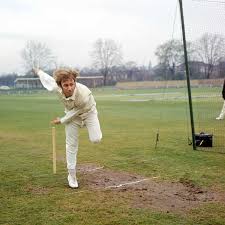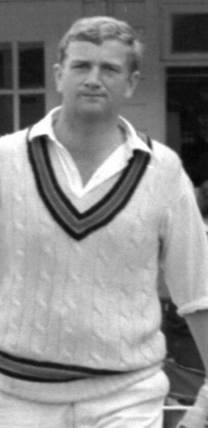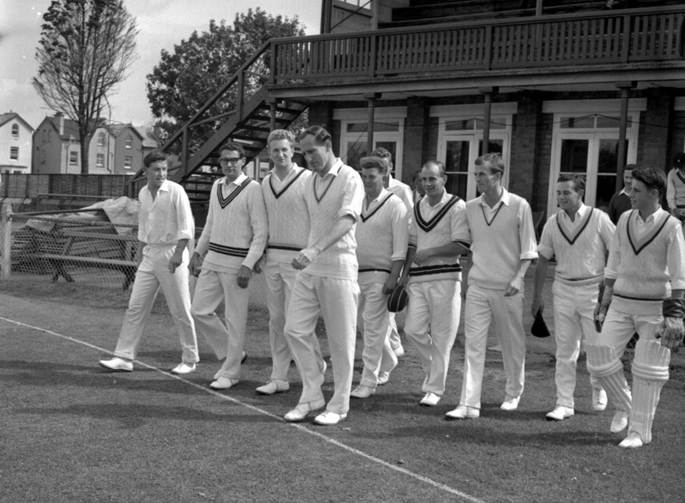A proper arm fast-medium service provider, threatening early in an opposition’s innings with away swing, typically pronounced, and afterward using a trade-mark off-cutter with the worn ball.

23rd April 1974 – at age 33

Dismissing Garry Sobers when on 79 for a Remainder of the World XI in opposition to England: The Oval, mid-August 1970 – Lever taking
7 for 83 from 33 overs within the first innings
Martin Chandler has written a well-rounded and perceptive account of Peter Lever’s first-class cricket profession, with loads of private insights (Cricket Internet, 3 March 2018). This piece focusses on the deeds of his dichotomous Check profession, and primarily serves as an adjunct to Martin’s overview.
I enterprise additional than Peter Lever himself to check out two of his fast successors within the first-class recreation: JK Lever and a shock participant – one which even many cricket nuts might not know something about. In order that readers know upfront: as a proportional of whole phrases, excluding photograph captions: PL will get 72% of my textual content, JKL will get 8% and the shock visitor will get 20%. (Apologies to all those that insist on getting the whole lot down to 2 decimal locations!)
To enterprise: Peter Lever was extremely profitable in opposition to Australia down underneath in 4 of his seven Check matches there through the 1970/71 and 1974/75 seasons – phenomenally so in one among them.
PL When Not Down Underneath
But, in his different ten Check matches, Peter Lever excelled in solely two of them, each of which had been at dwelling: in opposition to Pakistan taking 4 for 75 within the match at Headingly and in opposition to India taking 5 for 84 within the match at Outdated Trafford. 4 extra of his different ten Check matches had been in New Zealand, within the wake of two excursions of Australia – an general exhibiting of 4 wickets at 64.5 runs apiece. In all, Lever’s ten Assessments moreover these down underneath produced a return of 18 wickets for 856 runs – so captured at an extravagant 47.6 runs apiece.
His entire Check profession return being 41 wickets at 36.8 apiece, bowling in 31 innings. The common price being fairly a bit above the marker for prime achievement for fast-medium Check bowlers of contemporary occasions.
PL’s Doings Down Underneath
Lever’s exploits down underneath through the 1970/71 Check sequence included match figures of:
- 3 for 55 at Sydney
- 4 for 98 at Adelaide
- 4 for 66, the second time at Sydney
Throughout the 1974/75 sequence, he captured 9 wickets for 103 runs from 27 overs at Melbourne, following a void at Brisbane (nil for 53 and nil for 58, from a mixed 34 overs). A little bit unusually, of those three venues the place he succeeded, solely Melbourne is usually identified for having circumstances beneficial for swing bowling.
The arithmetic exhibits that, within the 4 profitable outings simply famous, Lever took 20 wickets for 322 runs: accordingly, at solely 16.1 runs apiece. A price double that determine would nonetheless have been respectable. In his seven Check matches down underneath mixed, Lever captured 22 wickets whereas conceding 653 runs: thus costing, on common, 29.7 runs every – which charges extremely for Australian pitches and climate circumstances, and making an allowance for the standard of the opposition.

Bald statistics are one factor, however they don’t imply loads with out the context. So what hinged on the matches involved in Australia and to what extent did Peter Lever’s greatest figures contribute to a workforce’s victory or staving off defeat?
Elaborating on Lever’s triumphs: the 1970/71 Check Collection
- Peter Lever’s 1970/71 deeds occurred throughout the context of England’s first post-WW2 sequence of 6 Check matches (pedantically, and misleadingly, labelled in Wisden’s Ebook of Check Cricket as a seven Check sequence – the scheduled 3rd Check at Melbourne, because of begin on 31st December, being rescheduled after rain brought on abandonment through the third day with none play).
Presumably pushed by internet income prospects, the authorities involved agreed to staging additional 6 match Ashes sequence in Australia in 1974/75 and 1978/79, and in England on 5 successive events: 1981,’85,’89, ’93 and ’97; earlier than reverting to custom.
- After being omitted for the 1st Check at Brisbane – a excessive scoring draw – Lever got here in for Derek Underwood making his debut within the 2nd Check on the WACA Floor (Perth), reflecting its fame for helping pacemen. This turned out to be one other excessive scoring draw during which Lever – taking up after Shuttleworth’s new ball stint – had a hand in decreasing Australia to 17 for 3 of their first innings – capturing Doug Walters’ wicket (making 7 runs), although ending with not more than 1/78. Centuries by Ian Redpath and Greg Chappell noticed Australia to a robust whole of 440, overhauling England by practically fifty runs. Lever once more dismissed Walters within the second innings throughout his 5 overs (for ten runs) because the match began to peter out – Australia ending with 100 for 3 wickets after being set a goal of 245.
- Lever performed a really helpful position within the subsequent match, at Sydney, capturing opener Invoice Lawry’s wicket early on in Australia’s first innings to have them 38 for two – ending with figures of two/32, one of the best of the trio delivering at above medium tempo. Australia’s whole of 236 fell practically 100 runs behind England.
Boycott collected an undefeated 142 at a sedate fee, to allow a goal to be set for Australia’s second innings of 416 runs. Lever adopted up with 1/24 from his 11 overs, capturing Doug Walters but once more (caught behind for 3), to have Australia 14 for 3, which successfully ended any try to chase. After which it was a procession of low scores, other than two batsmen who managed to get into double figures: Lawry undefeated for a really gradual 60 and Stackpole at quantity six making 30. The match being gained for England by John Snow who demolished Australia with 7/40 in a measly whole of 116 runs. England going 1-0 up, with three matches to return.
- Subsequent a disappointing outing for Lever at Melbourne, ending with out a wicket to his identify. Snow, Willis and Underwood couldn’t hold Australia’s scoring to inside winnable limits – making totals of 493/9 declared and 169/4 declared, to set England a win goal of 271 runs. This was by no means tried; one other tame draw ensuing.
- So England had been now one up with two matches nonetheless to be performed. It’s on to Adelaide, the place Boycott, Edrich and Fletcher on the high of the order laid the idea for England’s painstakingly constructed whole of 470 runs. Just for Illingworth, the dour – tactically astute – Yorkshireman, to then lose his nerve and fail to implement the follow-on after dismissing Australia when 235 runs behind. Lever had been the main gentle in limiting them within the first innings, taking the brand new ball with Snow and capturing 4 for 49, together with the Chappell brothers and Walters as soon as extra (once more caught behind).
The ultra-conservative Illingworth then set Australia 469 runs to win in 500 minutes (declaring at 233 for 4, largely because of Boycott’s undefeated century) – such a goal being thought to be extremely infeasible in these days. Australia proceeded slowly and safely, reaching 328 for 3 by the shut (at 2.85 runs per over) – one more draw eventuating.
- Again to Sydney for the essential sixth and last match, with England nonetheless holding a one-nil lead. After England spluttered, laboriously, to succeed in a mediocre 184 runs on first innings, Lever performed a significant position in holding the opposition underneath management – limiting their result in 80 runs. He captured two of the highest three within the order with the brand new ball (Ken Eastwood and Rod Marsh) – being entrusted with it for the third match in succession.
- At that stage, Australia had been 32 for 3 in reply, and never lengthy after that 66 for 4; then to be rescued by their center order. Lever ending with 3 wickets for 43 from simply on 15 overs, one of the best of England’s quartet of pacemen.
Constructing on a strong begin (94 for 1), England chipped away of their second innings to succeed in a complete of 302, setting Australia a really gettable goal of 223 runs. Lever acquired a significant early wicket, that of Ian Chappell at quantity 3 – Australia then 22 for two – after which Underwood, Illingworth and the customarily misleading medium tempo of Basil D’Oliveira doing practically the entire subsequent injury in limiting Australia to 160 runs of their second innings – giving England a win by 62 runs. Solely Keith Stackpole rose above 30 runs, compiling a reasonably brisk 67. Australia had threatened at 131 for five, however crumpled after Greg Chappell went for 30, stumped by Alan Knott from Illingworth’s economical off spin.
A Spell on the Outer
- After returning dwelling from New Zealand, Peter Lever put in passable performances in Assessments 2 and three in opposition to Pakistan. But he was then discarded – initially in favour of Snow together with Geoff Arnold and John Value – and went solely lacking in seven successive Check sequence. He would make an unsuccessful return in Check 1 in opposition to Australia at Brisbane within the 1974/75 sequence, going wicketless.
PL’s Triumph within the 1974/75 Check Collection
- Peter Lever was recalled for the match on this sequence at Melbourne – changing Bob Willis with a broken knee – though, by then, the sequence had already been misplaced by 4 convincing wins to none (with one match ending in tense draw).
- Right here, Lever put in match successful effort. He destroyed Australia of their first innings by taking 6 for 38, together with the preliminary 4 batsmen to be dismissed in a spell of six overs with the brand new ball. All had been caught within the slips and at gully: Ian Redpath, Rick McCosker, Greg Chappell and Ross Edwards. Simply two runs coming of their mixed bats. Australia slumped to 23 for 4 and, in the end, being all out for a mediocre whole of 152.
After England replied by amassing 529 runs – Mike Denness and Keith Fletcher making large centuries after a shaky begin to the innings – Australia’s second innings seemed promising with the third wicket falling not till 248 had been on the board. However, after that stage, nobody gave the eventual centurion, Greg Chappell, a lot help. Geoff Arnold, Tony Greig and Lever polished off the remainder with two wickets every. The final three wickets falling for simply 6 runs, together with Chappell bowled by Lever for 102, in an eventual whole of 373 – falling quick by an innings and a handful of runs. Lever, the excellent bowler – on each side – taking 3 for 65, giving him the match figures (talked about earlier) of 9 for 103. A welcome comfort win for England.
Fast Successors
Peter Lever was succeeded in Check matches by name-sake JK (John Kenneth) Lever, additionally of fast-medium tempo, although a left armer. JK grew to become extremely profitable as a seam bowler who additionally swung the ball in to proper handers.
Born eight and a half 12 months after Peter Lever, in September 1940, JK’s Check profession (1976-86) yielded 73 wickets from 38 innings: shut on two wickets per innings, acquired at a laudable 26.7 runs apiece. In his three Assessments in Australia (bowling in six innings), JK captured 13 wickets – 2.2 per innings – at 23.7 runs apiece, one-sixth decrease than his predecessor’s 28.4 apiece down underneath.
For Essex in first-class matches (1967-89), JK captured 1,473 wickets from 12,530 overs – a strike fee of 1 sufferer per eight and a half overs, claiming them at an enviable common worth of 23.5 runs.


JK practising in 1969 at Chelmsford, a week earlier than the primary match of the season

JK’s classical motion: England vs New Zealand: ODI, 15th July 1978
The unknown to most readers is the presence in first-class cricket, from 1974-81, of a Minor Counties left armer of comparable tempo to JK Lever. Additionally delivering in-swing to right-handers with the brand new ball, whereas afterward producing cutters when it acquired previous.
This participant being Doug Yeabsley – born at Exeter in January 1942 – who was ok to have earned an England cap. He occurred to be a schoolmaster of mine after I attended Haberdashers’ Aske’s Grammar College at Elstree in Hertfordshire: instructing there full-time from 1964 by means of to 2013, and being the lead cricket grasp as much as till the mid-Nineteen Nineties.


Devon vs Dorset at Paignton, 1963: Yeabsley third from left (age 21)

Devon vs Dorset at Paignton, 1971: Yeabsley entrance row, third from left
Doug Yeabsley was regarded by these within the know as one of the best newbie tempo bowler in England through the Nineteen Seventies and early-Nineteen Eighties. Ian Botham reckoned the was the second greatest left arm tempo bowler in England, after JK Lever. Yeabsley was approached by Somerset to show skilled, and by another counties, however they had been foiled by his need to proceed instructing in addition to the calls of rugby union – he was a back-row ahead for Harlequins for a lot of seasons and later a flanker for Saracens.
Think about his report when taking part in for the Minor Counties mixed workforce in opposition to these of touring Check international locations:
1974 vs the Pakistanis: 2/60 and three/45 (all being among the many high 5 batsmen within the order).
1976 vs the West Indians: 3/69 (Lawrence Rowe, Deryck Murray and Bernard Julien) and 1/32 (claiming Viv Richards).
1977 vs the Australians: 2/62 (David Hookes for 1 run and Kerry O’Keeffe for six runs) and a pair of/35 (Gary Cosier for 13 and Kim Hughes for two)
in a memorable victory by 6 wickets, following a declaration by either side.
1979 vs the Indians: 1/67 and a pair of/53 (all among the many high 4).
1980 vs the West Indians: 2/44 (claiming each openers, Faoud Bacchus for 7 and Desmond Haynes for 15) and 0-28.
1981 vs the Sri Lankans: 1/63 (claiming HM Goonatilleke at quantity 3).
Throughout his Minor Counties Championship profession – 31 seasons extending from 1959, at age 17 when nonetheless at St Luke’s Faculty in Exeter, by means of to 1989 – Yeabsley took 735 wickets (3.1 per two day match) at a mean price of 20.5 runs, while conceding solely 2.27 runs per over. Additionally a succesful decrease middle-order batsman, he averaged 21.3 runs from his 216 innings. His final full season being 1986, at age 44.
Yeabsley was identified for lengthy correct spells of miserly bowling, exemplified by a gap stint for the Minor Counties South workforce delivered to Hampshire’s Barry Richards (at age 28) and Gordon Greenidge (six months earlier than his Check debut), at Portsmouth in mid-Might 1974. His 11 consecutive overs conceded simply 14 runs.

Doug Yeabsley, Captain of Minor Counties South, tossing up with Somerset’s Captain, Brian Shut: Torquay, June 1974 (Yeabsley taking 3 for 38 in 11 overs)

